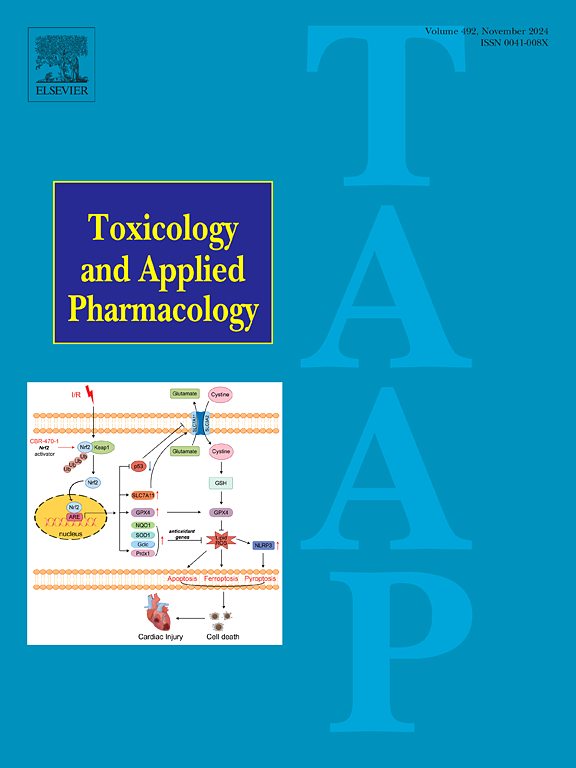Luteolin-7-O-glucuronide alleviates doxorubicin-induced cardiotoxicity by inhibiting PPAR-mediated ferroptosis
IF 3.4
3区 医学
Q2 PHARMACOLOGY & PHARMACY
引用次数: 0
Abstract
Inhibiting ferroptosis has been proposed to rescue myocardial cell death in Doxorubicin (DOX)-induced cardiotoxicity (DIC). Here, we aimed to investigate whether luteolin-7-O-glucuronide (LOG) alleviates DIC via ferroptosis suppression in zebrafish and H9C2 cardiomyocytes, as well as the potential mechanism. We found that LOG improved zebrafish cardiac function and mitigated the upregulation of CK-MB, cTnT, nppa, and nppb caused by DOX. Moreover, LOG suppressed the high levels of ROS, GSSG, and MDA in response to DOX and increased GSH activity and gpx4 levels in zebrafish. Additionally, LOG increased cell viability and the GSH/GSSG ratio, reduced oxidative damage and the accumulation of ferrous ions, and maintained mitochondrial function in H9C2 cells. Mechanistically, LOG improved the abnormal expression of key genes in the PPAR signaling pathway and ferroptosis induced by DOX. In conclusion, our study emphasized that LOG attenuates DIC by mitigating oxidative stress-triggered lipid peroxidation related to the inhibition of PPAR-mediated ferroptosis.

木黄素-7- o -葡萄糖醛酸酯通过抑制ppar介导的铁下垂减轻阿霉素诱导的心脏毒性
抑制铁下垂已被提出挽救心肌细胞死亡的阿霉素(DOX)诱导的心脏毒性(DIC)。在这里,我们旨在研究木犀草素-7- o -葡萄糖醛酸酯(LOG)是否通过抑制斑马鱼和H9C2心肌细胞的铁下垂来缓解DIC,以及可能的机制。我们发现,LOG改善了斑马鱼的心脏功能,减轻了DOX引起的CK-MB、cTnT、nppa和nppb的上调。此外,在DOX的作用下,LOG抑制了斑马鱼体内高水平的ROS、GSSG和MDA,并增加了GSH活性和gpx4水平。此外,LOG还能提高H9C2细胞的细胞活力和GSH/GSSG比值,减少氧化损伤和亚铁离子的积累,并维持线粒体功能。在机制上,LOG改善了PPAR信号通路关键基因的异常表达和DOX诱导的铁下垂。总之,我们的研究强调,LOG通过减轻氧化应激引发的脂质过氧化作用来减轻DIC,这与ppar介导的铁下垂的抑制有关。
本文章由计算机程序翻译,如有差异,请以英文原文为准。
求助全文
约1分钟内获得全文
求助全文
来源期刊
CiteScore
6.80
自引率
2.60%
发文量
309
审稿时长
32 days
期刊介绍:
Toxicology and Applied Pharmacology publishes original scientific research of relevance to animals or humans pertaining to the action of chemicals, drugs, or chemically-defined natural products.
Regular articles address mechanistic approaches to physiological, pharmacologic, biochemical, cellular, or molecular understanding of toxicologic/pathologic lesions and to methods used to describe these responses. Safety Science articles address outstanding state-of-the-art preclinical and human translational characterization of drug and chemical safety employing cutting-edge science. Highly significant Regulatory Safety Science articles will also be considered in this category. Papers concerned with alternatives to the use of experimental animals are encouraged.
Short articles report on high impact studies of broad interest to readers of TAAP that would benefit from rapid publication. These articles should contain no more than a combined total of four figures and tables. Authors should include in their cover letter the justification for consideration of their manuscript as a short article.

 求助内容:
求助内容: 应助结果提醒方式:
应助结果提醒方式:


